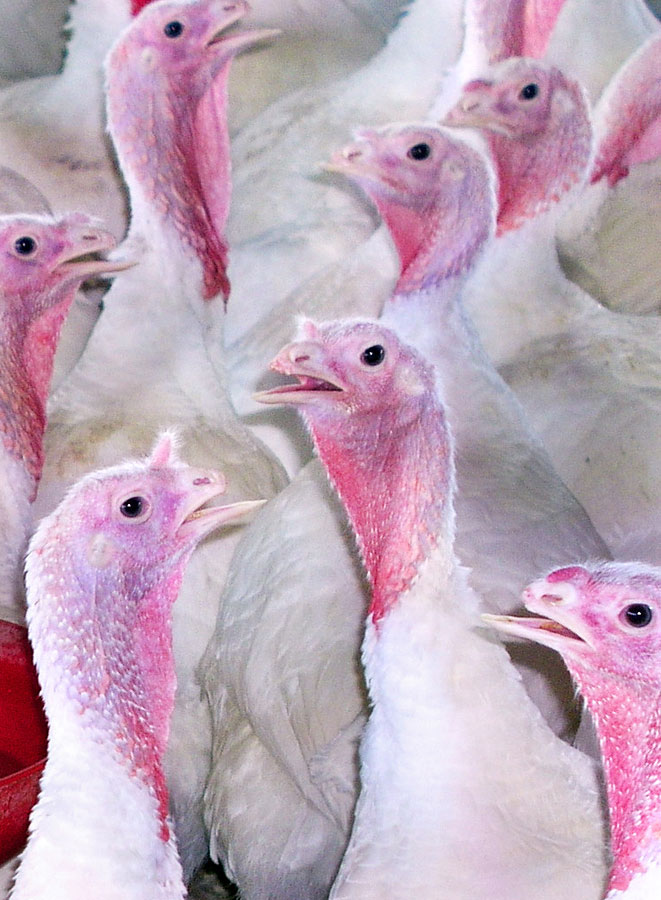Virginia Tech researchers contribute to turkey genome sequencing

An international consortium of researchers has completed the majority of the genome sequence of the domesticated turkey, thanks in part to the efforts of Virginia Tech faculty members.
The research team will publish “Multi-Platform Next-Generation Sequencing of the Domestic Turkey (Meleagris gallopavo): Genome Assembly and Analysis” in the journal PLoS Biology (Public Library of Science) on Sept. 7, 2010.
“To date, more than 90 percent of the domesticated turkey genome has been sequenced and assembled,” said Rami Dalloul, assistant professor of animal and poultry sciences in Virginia Tech’s College of Agriculture and Life Sciences. The majority of data are derived from the 10 largest chromosomes, called macrochromosomes, and researchers in the consortium are still searching for the best route to sequence the remaining microchromosomes. “We have already described thousands of genes previously unknown to avian scientists,” Dalloul said.
Also of interest are the sequences of the sex chromosomes “Z” and “W,” which were poorly covered in the past.
In 2008, the research consortium set out to map the genetic blueprint for the domesticated turkey, the fourth-most popular choice of meat in the United States. The following year, Virginia Tech and the University of Minnesota received a two-year, $900,000 grant from the U.S. Department of Agriculture to complete the genome sequence, which promises new data for avian researchers and, ultimately, a better quality product for turkey producers and consumers.
“In the short term, the genome sequence will provide scientists with knowledge of specific genes that are important in meat yield and quality, health and disease resistance, fertility, and reproduction,” Dalloul said. “For example, we don’t always know the mechanism for how host-pathogen interactions work. The genome sequence will allow us to better understand this process, which will in turn give us a better understanding of disease prevention and treatment.”
According to Dalloul, the genome sequence will have long-term benefits for turkey producers as well. “Poultry producers may be able to use the knowledge we gain from the genome sequence to grow turkeys faster and healthier, and if they can produce the same size bird in a shorter period of time, they can also save money,” he said. An improved understanding of genetic variation in this species and in breeding populations will also lead to development of new tools that producers can use to breed turkeys that have desirable texture, flavor, and leanness, which will directly impact consumer products.
In addition, the genome sequence may have applications in the biomedical field. Ed Smith, professor of animal and poultry sciences at Virginia Tech, is investigating an avian condition similar to dilated cardiomyopathy in humans. Other consortium members — Roger Coulombe at Utah State University and Kent Reed at the University of Minnesota — are studying the effects that aflatoxins have on turkeys. Aflatoxins are naturally occurring carcinogenic chemicals produced by fungi that suppress the immune system. The domesticated turkey is the most aflatoxin-susceptible species known.
Clive Evans, director of the Core Laboratory Facility at the Virginia Bioinformatics Institute, said, “The availability of the Roche GS-FLX™ Titanium sequencing technology at [the institute] allowed the turkey research consortium to quickly and efficiently establish an early draft of the turkey genome.” This draft was extended in 2009 with data from the Illumina sequencing platform at the U.S. Department of Agriculture-Agricultural Research Service and assembled by scientists at the University of Maryland to produce the current genome assembly. The use of these next-generation sequencing technologies provided the turkey genome sequence assembly at a fraction of the cost of producing the red junglefowl genome assembly (the same species as the domesticated chicken) in 2004.
The international consortium spent the last year annotating and analyzing the draft genome sequence, which culminated in “fleshing out the intricacies of the turkey’s genetic blueprint as described in detail in the PLoS Biology paper,” Evans said. The research team hopes the integrated approach used to obtain the turkey genome will provide a model for creating gene- and chromosome-level assemblies for other species with agricultural, ecological, or evolutionary importance.




